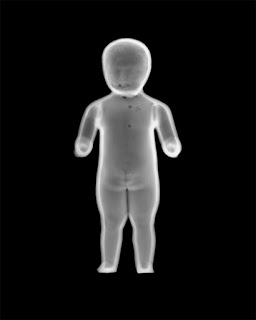Pretty Baby: Photographer Lisette de Boisblanc Can See Right Through You
There is something innately fascinating about hidden worlds: the subway tunnels that underlie cities; the phosphorescent creatures lurking in the ocean's sunless depths; the insular subcultures of bikers and circus folk. New Orleans photographer Lisette de Boisblanc's photos in Taken by the Fog at Jennifer Schwartz Gallery (which moves to the Westside this month) document a hidden world, too, one that serves as a metaphor for the similar intangibles that lurk inside our own flesh casings.
Something between a photographer and a scientist (in fact, the artist once worked in science), de Boisblanc has X-rayed a bevy of her grandmother's dolls against an inky black background. The images bear a distinct resemblance to Man Ray's photograms, which used sunlight to achieve a similarly ghostly image.
The result of de Boisblanc's X-ray process is an eerie catalogue of the hidden innards of these creatures rescued from their watery post-Katrina graves. Inside, there are elaborate networks of weights and strings that allow a baby doll's eyes to open and close or which anchor arms and legs to torsos. There are also sharp metal pins and pieces, some of which appear to be part of the dolls' mechanics and some more mysterious in origin. The images conjure up the sadism of little children, shearing their baby dolls' hair off or plunging daggers into their bodies. But they can also evoke more disturbing scenarios, of child abuse and its secret, hidden wounds. The works are chilling for being so evocative of human injury as in "Interview with the Ward Part 1," which depicts a G.I. Joe action figure. The doll's ready-for-battle sneer suddenly looks more like the rictus of death. Splayed out and seen from above, he resembles a battlefield casualty.
The hidden networks lurking inside de Boisblanc's dolls bring to mind circulatory systems and spinal columns but also suggest some abstracted brain or consciousness. The systems take on the characteristics of their age. The porcelain dolls have jerry-rigged systems within their porky, plump bodies. But the Barbie-type dolls have guts as sleek and squared-away as the Space Age that spawned them.
De Boisblanc's close-up images of her baby dolls' faces are the eeriest, reminiscent of the jarred embryos of freak shows and medical labs. With their fake, painted-on features obliterated in the X-ray process, they bear an uncanny resemblance to real babies. Their faces have an unformed but still recognizable appearance, with tiny gaping mouths open in some existential wail, black pits for eyes, their fat, amorphous heads floating in an amniotic universe of pitch black. In the creepy little triptych "Zen," a kind of fetal form lurks inside a plastic casing. It appears to be a doll whose emotions can change depending upon how its head is turned, like Dr. Jekyll and Mr. Hyde personalities warring to get out.
I know what you're thinking. Photographs of dolls ... really? Haven't we trod this road before? De Boisblanc's work certainly has an easily digestible quality that could allow it to be seen only for its superficially strange, gothic air. But there are ripples of something uncannier in this compelling work. There is a reminder of mortality and the tribulations of our own experiences to give these ghostly creatures intellectual heft and something deeper than simple shock value.—Felicia Feaster




Comments